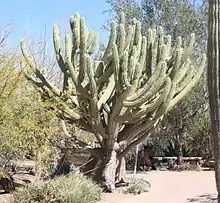Stetsonia coryne
Stetsonia coryne, the toothpick cactus, is the sole species in the cactus genus Stetsonia. Stetsonia coryne grows to a height of 15 to 25 ft (4.6 to 7.6 m) tall. It has white flowers.
| Stetsonia coryne | |
|---|---|
 | |
| Scientific classification | |
| Kingdom: | Plantae |
| Clade: | Tracheophytes |
| Clade: | Angiosperms |
| Clade: | Eudicots |
| Order: | Caryophyllales |
| Family: | Cactaceae |
| Subfamily: | Cactoideae |
| Tribe: | Cereeae |
| Subtribe: | Rebutiinae |
| Genus: | Stetsonia Britton & Rose |
| Species: | S. coryne |
| Binomial name | |
| Stetsonia coryne | |
Description
The plant is large, arborescent habit , tree-like reaches a growth height of 5 to 8 meters up to 12 meters. The trunk is thick and short, measuring about 4 dm in diameter, with numerous erect or somewhat bent branches form from a trunk. The blue-green shoots, turn greenish-gray with age, usually not jointed and have a diameter of 9 to 10 centimeters. There are 8 to 9 blunt-edged, somewhat notched ribs that are 1 to 1.5 centimeters high. The yellow spines, which later turn black, are straight and stiff. The central spine grows to 2–5 cm long and are thickened at the base., the 7 to 9 spreading marginal spines to 3 centimeters long. There is a single central spine, straight and more robust, which can measure up to 8 cm in length. All are black or yellowish-brown in color, although they eventually turn white with a dark tip.
It flowers from October to April with funnel-shaped flowers that are white and grow up to 15 centimeters in diameter. They open at night and often remain open until the next day. The pericarp is covered with numerous, roof-tile-like, the long corolla tube with scattered scales.
The plant fruits from January to May and its fruit is a fleshy berry 4 cm in diameter ovoid, scaled, edible fruits are green to reddish and have a drooping floral remnant. The broadly oval, shiny blackish-brown seeds are 1.7 millimeters long and 1 millimeter wide. They are humped with a fine wrinkled pattern.[2][3]
 Large plant growing in habitat in Argentina
Large plant growing in habitat in Argentina branch
branch.jpg.webp) Flower
Flower Spines
Spines
Taxonomy
The first description as Cereus coryne was made in 1850 by Joseph zu Salm-Reifferscheidt-Dyck.[4] Nathaniel Lord Britton and Joseph Nelson Rose placed the species in their newly established monotypic genus Stetsonia in 1920. The genus was named to honor Francis Lynde Stetson, a New York attorney and plant lover.[5]
Distribution
Stetsonia coryne is distributed in the high-altitude arid regions,the deserts and dry forest (Gran Chaco) of north-western Argentina, as well as in Bolivia, Paraguay and the Brazilian state of Mato Grosso do Sul.
Conservation
In the IUCN Red List of Threatened Species, the species is listed as "Least Concern (LC)".[1]
References
- Oakley, L.; Pin, A. (2017). "Stetsonia coryne". IUCN Red List of Threatened Species. 2017: e.T152044A121576661. doi:10.2305/IUCN.UK.2017-3.RLTS.T152044A121576661.en. Retrieved 20 November 2021.
- Eggli, Urs; Newton, Leonard E. (2004-03-11). Etymological Dictionary of Succulent Plant Names. Springer Science & Business Media. p. 55. ISBN 3-540-00489-0.
- Anderson, Edward F.; Eggli, Urs (2005). Das grosse Kakteen-Lexikon (in German). p. 607. ISBN 3-8001-4573-1.
- Salm-Reifferscheidt, Joseph; Georgi, Carl (1850). Cacteae in horto Dyckensi cultae anno 1849, secundum tribus et genera digestae : additis adnotationibus botanicis characteribusque specierum in enumeratione diagnostica cactearum Doct. Pfeifferi non descriptarum /. Bonnae: Apud Henry & Cohen, typis C. Georgii. doi:10.5962/bhl.title.120333.
- Everett (1 July 1982). Encyclopedia of Horticulture. Taylor & Francis. p. 3235. ISBN 978-0-8240-7240-7. Retrieved 31 August 2012.
External links
 Media related to Stetsonia coryne at Wikimedia Commons
Media related to Stetsonia coryne at Wikimedia Commons Data related to Stetsonia coryne at Wikispecies
Data related to Stetsonia coryne at Wikispecies
